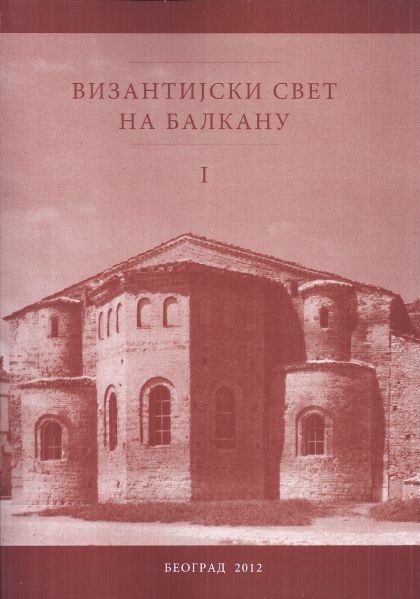Светачки лик у контексту: један нерасветљени пример из ексонартекса цркве у манастиру Трескавац
The Saint’s Image in Context: A Neglected Example from the Exonarthex of the Treskavac Monastery Church
Author(s): Vesna Milanović
Subject(s): Cultural history, Visual Arts, 13th to 14th Centuries, 15th Century, Eastern Orthodoxy
Published by: Vizantološki institut SANU
Summary/Abstract: The images which are the focus of the paper belong to the oldest of several existing fresco ensembles in the sacral complex of Treskavac resulting from different and chronologically clearly separated ktetorial undertakings and renewals between the 14th and 19th centuries. Dating from the times of King Du{an, these images apparently form part of the original painted decoration of the space whose lateral ends are surmounted by domes, and whose emphasized tripartite shape is a result of 19th century alterations. Massive separating wall areas were introduced into the previously undivided and much more integrated internal composition of the exonarthex, thus not only partitioning the area and making it significantly narrower, but at the same time, unfortunately, hiding part of the authentic medieval frescoes on the east and west walls near the entrances.
This paper is based on the findings related to recognising the previously unidentified remaining part of a holy monk figure, presented with an interesting and unusual iconographic symbol in his hand — a branch with leaves and fruit. The author of the text points out that it is the branch of a Paradise apple tree, and that the image is that of an otherwise quite seldom depicted figure of Euphrosynus the Cook. The surviving examples of the monk’s vitae story present him as a meek and humble member of the brotherhood in a desert monastery by the River Jordan, despised and even taunted by the other brothers — but at the same time, in the central episode of the story, provide the image of a special person, chosen by God, blessed with dwelling in the Garden of Eden and enjoying the fruit of heavenly trees. It is interesting and worthy of attention that the Treskavac image of St. Euphrosynus stands apart from the incompletely preserved but relatively numerous and homogenous row of holy monks in the zone of standing figures on the west wall, and that his solitary bust portrait is joined to a particular, “unrelated” group of images, i.e. to a quite different category of iconographic content, on the opposite wall surfaces in the southern part of the exonarthex.
Part of the findings presented in the paper resulted from reflections on the saint’s unusual and highly specific iconographic attribute, and revealing a layer of meaning that bestowed on this attribute the dimension of a particular biblical and Christian topos. The other part of the findings relate to recognising and interpreting the specific function of the very position given to the saint’s figure among the mentioned group of only seemingly unrelated or not specially related images in the southern part of the Treskavac exonarthex. Among the most prominent ones is the composition of the Baptism of the Lord, also excluded from the category of contents it otherwise usually belongs to (the Great Feasts cycle), and, in contrast to the usual topography, placed in the lowest fresco zone, in the spot immediately below St. Euphrosynus’ image. In all probability, the relevant group of scenes was to include also the bordering representative depiction of a Serbian ruler with the divine investiture motif, in the southern portion of the eastern wall of the central part of the exonarthex area, as well as the nearby contents belonging to the wide-ranging and complex Menologion cycle from the upper zones of the building. Formally the most prominent and most noticeable illustrations are for the March days of the Cycle — the Annunciation to the Blessed Virgin Mary (with a pictorial allusion to the Holy Spirit’s power coming down from Heaven) and the Martyrdom of the Forty on a frozen lake (with the detail of placing crowns of heavenly glory on the naked bodies of the martyrs) — situated in the calotte above the southern part of the exonarthex that bears a monumental image of Christ Emmanuel at the centre. Although at the same time also part of a special whole in the central part of the exonarthex, south of the main entrance to the church, the content of the fresco depicting King Du{an’s investiture with a crown from an angel’s hand and the motif of receiving his power Dei Gratia, it was with good reason that its south, now hidden end, abutted on the depiction of Christ’s Theophany at the Jordan in the adjacent area of the wall, whose contents form part of the structure of the frescoes in the mentioned bay under the calotte. All the findings and observations on the selection and relations of the images given here and supported by arguments serve to confirm and shed more light on the special segment in the content of the painted programme from King Du{an’s times — thematically cohesive and integrated through a unique symbolism, and not lacking in specific and indicative analogies in the monuments from this epoch. The concept of the programme, stressing different aspects of the soteriological and eschatological implications of the baptismal theme and the Christian notion of the era of “the grace of God” — where the sacrament of baptism is seen as the “gates of the New Heaven” — at the same time also justifies the identification of the said part of the space with the original position of the existing, and at a later time dislocated, authentic medieval stone agiasma of Treskavac.
Book: Византијски свет на Балкану I-II
- Page Range: 459-486
- Page Count: 28
- Publication Year: 2012
- Language: Serbian
- Content File-PDF

